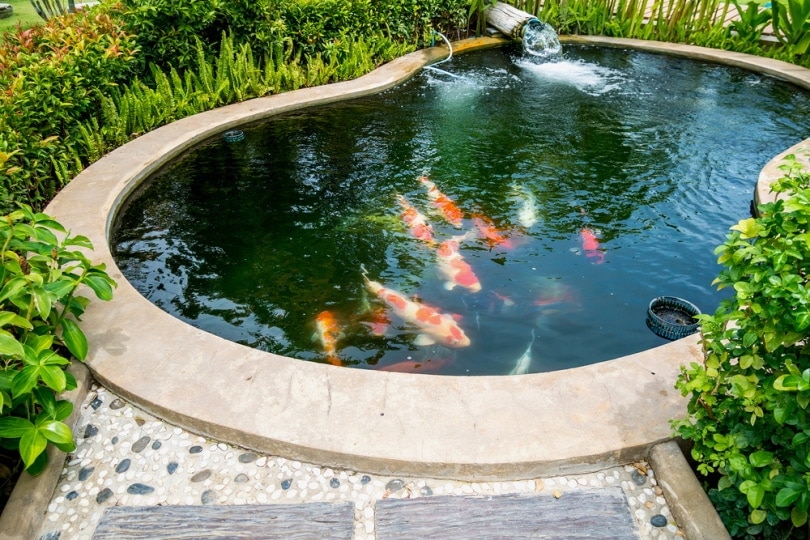
Pond dyes are a pretty cool thing if you have an outdoor pond, and this is true for several different reasons. You might want to use pond dye to turn your simple little pond into a beautiful and colorful backyard oasis. They can definitely help make your pond look much more visually appealing, but there is a lot more to it than that still.
Using pond dye actually comes with quite a few different benefits that are worth mentioning. Now, this is only true if you buy some really high-quality stuff. This stuff can come in liquid or powder forms, both of which can be okay, but you do need to make sure that you go with a decent option.

A Quick Comparison of Our Favorites in 2o22
The 10 Best Pond Dyes
Below you will find a list of the best pond dyes available today, each reviewed and ranked based on their best uses, pros, and cons.
1. Crystal Blue Pond Dye
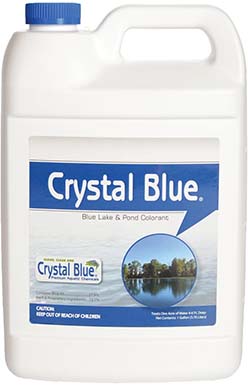
If you like blue pond dye, this is one of our personal favorite options. First and foremost, Crystal Blue Pond Dye is perfectly safe to use around fish and is 100% non-toxic, which is really important, to say the least. In terms of dosing, a single container of this stuff can effectively dye 1.5 million gallons of water.
That being said, it should not be used for ponds that are deeper than 6 feet, or else more will be needed. Just pour it out along the shoreline from a slow-moving boat for the best results.
It won’t stain anything, and it won’t interfere with other chemicals that you may have put in your pond either. All in all, we think that Crystal Blue Pond Dye is the best option at this time.
2. Pond Logic Pond Dye
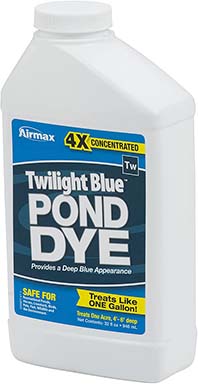
Pond Logic Pond Dye is another good choice to keep in mind. This is a blue pond dye and is honestly not all that different from our first choice. Just like our number one choice, this stuff is non-toxic, it won’t stain your fish, and it won’t harm them either. At the same time, it helps with algae and predator control, plus the blue color looks really nice too.
The only real difference is that one bottle of Pond Logic Pond Dye is good for 10,000 gallons of water, whereas our number one choice was good for 1.5 million gallons. This is one of the more cost-effective options out there, which is thanks to its super-concentrated formula.
It’s a very similar option to our number one choice, but you may prefer this one for one reason or another.
3. Sapphire Blue Lake & Pond Dye
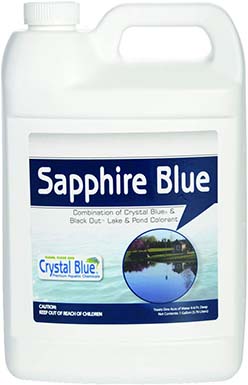
This is a very interesting choice to go with. Sapphire Blue Lake & Pond Dye features a mix of two-thirds blue dye and one-third black dye, making for a really deep and dark blue water dye. It might not look quite as vibrant or bright as our first two options, but it definitely does a great job at predator and algae control.
The dark color definitely comes with some nice benefits. One thing that needs to be mentioned is that you will need about twice as much pond dye if there is no dye already in the pond.
On a positive note, Sapphire Blue Lake & Pond Dye is fish-friendly, non-toxic, and should not stain clothes or skin either.
4. Pond Champs Pond Dye

This is a really nice vibrant blue pond dye to consider getting. People really love how it turns the water a bright, vibrant, and beautiful shade of blue. In our opinion, this Pond Champs Pond Dye is one of the better-looking options out there. Also, this stuff is 100% non-toxic, safe for fish, it can be used in swimming water, and can be used for potable water too.
It won’t harm or stain your fish either, which is always a big benefit. 1 gallon of this stuff will treat an acre of water that is 6 feet deep. So, in other words, this is not the most concentrated formula, so you will have to use a fair bit of it to achieve the results you are looking for. It will take about 2 days for Pond Champs Pond Dye to fully mix into the water.
5. Nature’s Blue Pond Dye

This particular option is a very unique pond dye when compared to the other pond dyes we have looked at so far. Nature’s Blue Pond Dye is a powder dye instead of a liquid one. People really like this because it causes much less mess and takes less effort to dye a pond than liquid dye. Just open up the bag, pop a tablet into the pond, and you are good to go.
A single purchase of Nature’s Blue Pond Dye will dye a full surface acre of pond water down to 6 feet deep. This is a great choice to go with if you have a decorative pond with lots of greenery surrounding it.
One thing that needs to be noted is that this stuff is meant for large-scale use, not for small ponds. A single packet of this stuff, when used in a small pond, will make the water so dark that you won’t be able to see your fish.
6. Aqua Shade Organic Plant Growth Control

In terms of algae, plant, and predator control, Aqua Shade Organic Plant Growth Control is one of the best pond dyes out there right now. It contains a bunch of algaecides and herbicides which are specially meant to control pond weeds and algae.
However, at the same time, it is also perfectly safe to use around your fish, plus it won’t kill those beautiful floating pond lilies either.
Aqua Shade Organic Plant Growth Control is best used in water deeper than two feet if you expect to see the best results. This stuff is non-toxic and can be used for swimming water, irrigation, and it won’t harm your fish either. That being said, don’t drink water that has been dyed with Aqua Shade Organic Plant Growth Control because it won’t end well for you.
This stuff is a really dark blue, so it does look very nice. One bottle of this stuff is enough to treat 4 surface acres of water to a depth of 5 feet.
7. KoiWorx Blue Dye
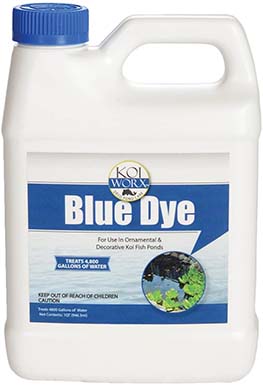
This is one of the lighter blue pond dyes out there right now. KoiWorx Blue Dye will add a nice blue tint to your pond water, thus making it look really nice. It is best used for its aesthetic purposes.
It does an okay job at controlling algae and keeping predators at bay. However, since it is not all that dark, it won’t do as good a job at algae and predator control as some of the darker blue options that we have looked at so far.
We do like how KoiWorx Blue Dye is safe for aquatic life, it is non-toxic if you come into contact with it, and it won’t stain your fish, plants, or rocks either. However, be sure to wear gloves because it will stain your skin and clothes. One single bottle of KoiWorx Blue Dye can treat 4800 gallons of pond water with ease.
8. Pondworx Lake and Pond Dye

Pondworx Lake and Pond Dye is very similar to many of the other blue pond dye options we have looked at here today, but it is still a good option nonetheless. First off, it is completely non-toxic, safe to use around fish, won’t stain fish, plants, or rocks, and is safe to use for swimming and irrigation too.
If you are concerned about safety and being eco-friendly, this stuff is probably one of the best options to go with right now.
All you need to do is pour the Pondworx Lake and Pond Dye into the pond directly from the shore. This dye should last about 3 days, but it does depend on a couple of factors.
A single bottle of Pondworx Lake and Pond Dye is enough to effectively dye 1 surface acre of pond water to a depth of 6 feet. This stuff provides your pond with a beautiful blue coloration, and it does a decent job at algae and predator control too.
9. EasyPro Pond Pond Dye

This particular pond dye is a little lighter in color than some of the others we have looked at. It is a fairly light blue in color, which will provide your pond with a really nice look. The biggest benefit that comes with EasyPro Pond Pond Dye is that it will make your pond look amazing.
That being said, while it will offer a certain degree of predator protection and algae control, it is not the best option for these purposes. When diluted properly, EasyPro Pond Pond Dye is not harmful to fish, birds, or surrounding plants. It is non-toxic and even safe to swim in when used properly. However, be sure to wear gloves because it will stain your skin.
10. TotalPond Pond Blue

Just to be clear, TotalPond Pond Blue comes in a fairly small bottle, with one 8 oz bottle being enough to treat roughly 4,000 gallons of water. In other words, it should be more than enough for a small koi pond. We do like how TotalPond Pond Blue is non-toxic, safe to swim in, won’t stain fish or rocks, and is safe for fish to live in as well. It is definitely a safe option to go with.
TotalPond Pond Blue is a fairly dark blue in color, which means that it does a fairly good job at keeping predators away from your fish, plus it does a pretty good job at stopping algae growth too.
On that same note, TotalPond Pond Blue will definitely provide a nice look for your pond, one that goes well with the surrounding greenery.
Buyer’s Guide: Choosing the Best Pond Dyes
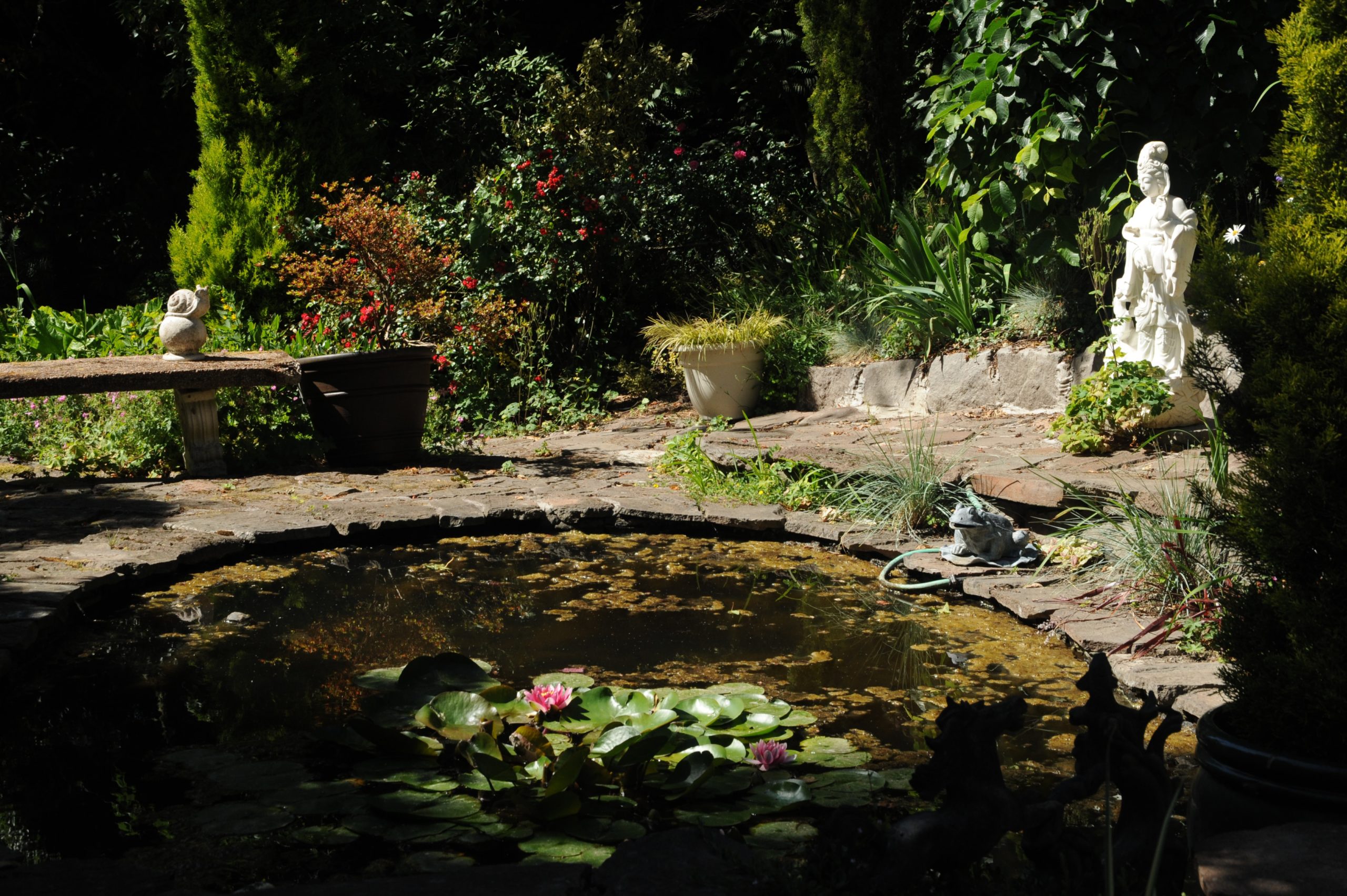
As with all products and items in existence, there are good things and bad things. This is also true for pond dye, which comes with quite a few benefits, but a couple of disadvantages too.
However, as far as we are concerned, the pros of using pond dye greatly outweigh the cons, which is, after all, why we are here today. So, let’s take a closer look at the pros and cons of using pond dyes.
- First and foremost, the main benefit of using pond dyes is that they help to control algae growth, as well as the growth of aquatic weeds. The reason for this is that pond dye does a really good job at blocking UV light penetration from the sun. In other words, it stops a good portion of UV rays from getting past the pond water’s surface (the right plants can also help keep pond water clean, more on that here).
- Algae and pond weeds need a lot of UV light to bloom, so blocking the light out will help to control algae. Keep in mind that pond dyes won’t remove algae from your pond if there is already a lot of algae in there (we have covered a separate guide on safely removing algae here). If this is the case, you will have to treat the problem first, but pond dye does make for a good preventative measure.
- Another big benefit of using pond dyes in your pond is that it helps protect your fish. If you have an outdoor pond, you are probably aware of the fact that birds and other predatory animals love to munch on the fish in your pond. Well, pond dye helps to block out light, make the depths darker, and it helps provide some camouflage for your fish too.
- It is a good way to stop predators from eating your fish. Now, this is not totally foolproof, but it is better than nothing at all. Predators, besides not being able to see the fish, might also notice that the pond has a different color and odor, thus deterring them.
- Using pond dye can actually make shallow water look much deeper. This is beneficial for people who have a shallow pond but want it to appear much larger.
- Pond water that has been dyed with pond dye is usually always environmentally friendly. These things are made with people, pets, and fish in mind. You can use this water to irrigate crops, and swim in, and you can even eat the fish from these ponds.
- As long as the proper dosing instructions have been followed, there should be no problems with staining either. On a side note, this stuff is really easy to use. All you need to do is pour it into the pond while following the proper dosing instructions, and it will mix throughout the pond in a matter of hours.
- The next big benefit that you get from using pond dyes is that they make the water look much better. After all, this is probably the main reason why people look into pond dyes in the first place, to color the water and make it look much better. Sure, algae and predator control are both added benefits, but the dazzling blues, yellows, greens, and blacks that pond dye can add to a pond are usually the primary reason for choosing to use pond dye.
- You need to be aware of the fact that failing to wear the proper protective gear can result in long-lasting stains. Wear gloves when using pond dye because it will stain clothes, hair, skin, and everything else it comes into contact with.
- Pond dyes, while being good for algae control and for keeping predators away, they do not always work 100%. They are not foolproof and should not be regarded as total solutions to this problem.
- If you have a pond with lots of watersheds, especially if you live somewhere with abundant precipitation, beware that the cost of dying your pond will be significant. If there is a high water exchange rate, you will need to keep adding more dye into the water, which becomes quite a laborious and expensive process.
- On that same note, these dyes are usually biodegradable and will fade with exposure to the sun, so adding more is often needed, especially in rainy spring months and bright summer months.
- Pond dyes will not kill weeds and floating plants that are above the surface of the water. Pond dyes are notorious for being finicky when it comes to plants. They will usually kill off most pond weeds and forms of algae that are submerged but not emergent or floating plants. This can be a good or bad thing depending on how you look at it.
How Long Does Pond Dye Last?
If you are going to start buying pond dye and using it on a regular basis, you probably want to know how long it is going to last for. Honestly, this is really difficult to say, and it depends on various factors.
Generally speaking, we can say that average pond dye will last anywhere from 3 to 9 weeks. We know that this is very vague, but as we said, it depends on many different factors. Obviously, if you use more dye, it is going to last for a longer period of time. Second, it does also depend on the brand name and quality of the specific pond dye in question.
Next, if there is a lot of watershed and water exchange, you will need to keep adding more dye to compensate for the added rainwater. Sunlight is known for causing pond dye to degrade and fade, so the more sun there is, the less time the dye will last for.
Heat and water movement can also have an effect on the longevity of pond dye. If you want your pond dye to last for as long as possible, be sure to buy one that is of high quality, is resistant to photogenic degradation, that your pond is not exposed to too much sunlight, and that there is not too much watershed.
Yet, we know that controlling some of these things can be hard, especially when it comes to sunlight and watershed, but just do your best.
How To Get The Most Out Of Your Pond Dye
- Pond dyes are not some kind of fix-all solution, nor do they always have the same efficacy. To make sure that you maximize the results of pond dye, follow these few tips that we have outlined below.
- Never add more pond dye to the water than is instructed in the dosing instructions. It is better to use too little than too much. If you use too little, you can always add a bit more. However, using too much, more than the instructions call for, the results could be dangerous.
- You should treat algae problems before adding dye. While pond dye is good for preventing algae blooms, it won’t really remove algae if there is already a substantial amount of it in the water. Algae can cause pond dye to be ineffective and not last for a very long time, so treating algae beforehand is recommended.
- If you have any activated carbon products in the pond, such as an activated carbon filtration unit, it will decrease the length of time the pond dye will last for; plus, it will lessen the brightness and depth of color.
- Natural substances called tannins are present in wood and plants and can turn your water a brown or yellow shade. If you are going to use pond dye, you should treat for tannins before using the dye, or else a blue dye could mix with the already yellow water and create an unappealing shade of green or whatever other color happens to appear.
- There should be some decent water flow in the pond in order to get the pond dye to disperse evenly in around 24 hours.

What Color Dye Is Best?
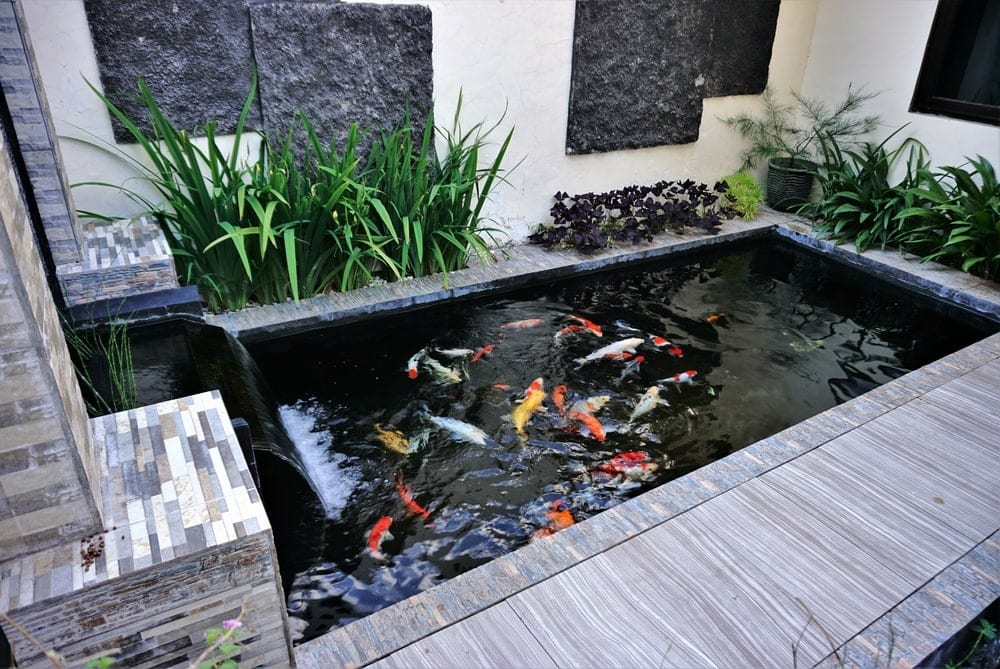
Now, there are various different colors of pond dyes, each of which does look really nice. However, each different color of pond dye comes with different benefits and disadvantages that you might have never thought of.
The most common pond dye colors include blue, turquoise, and black, but there are a few others too. Some people like using a bit of yellow with their blues, but generally speaking, the first 3 we mentioned are the most commonly used ones.
Black
Okay, so black pond dye is actually not one of the more common ones, but it is worth mentioning anyway. Black dye tends to create a reflective layer on the water’s surface, which is beneficial for a couple of different reasons.
First, the reflections off of trees and surrounding foliage look really nice. Also, the dark black color combined with the reflections from the water’s surface is great for deterring predator animals and for blocking out UV rays, thus controlling algae. However, black dye doesn’t look as nice in ponds as blue or turquoise and is therefore not used all that often.
Blue
Blue is the most commonly used pond dye color out there. For one, it looks amazing and will provide your pond with a really elegant and calm blue color. They make your pond look vibrant, plus they match well with the surrounding greenery. Blue pond dyes are also known for making the water look very natural.
Blue dye does a good job at blocking out UV rays, which is a big bonus for algae control. It also does a fairly good job at keeping predators from seeing your fish. That being said, while it looks better than black dye, in terms of predation and algae control, it is not quite as effective as black dye.
Turquoise
Turquoise is a great color for ponds in terms of creating a really serene, natural, and beautiful look. However, while it will control algae and predators to a minimal degree, it does not do as good a job as either blue or black dye. If you are going to go with turquoise pond dye, it should only be for the look.

Is Pond Dye Safe For Fish?
Yes, as long as you follow the proper dosing instructions, the vast majority of pond dyes out there should be perfectly harmless to your fish. In fact, most varieties are so harmless that you could eat the fish that have been living in the dyed pond.
Heck, you can swim in the pond too if you feel like it. Remember, these dyes are specifically designed to be used in ponds that have fish in them, so yes, they are safe for fish.

Conclusion
As you can see from our best pond dye reviews section, there are tons of good options to go with. Just make sure that you know what color you want to use and how much of it you are going to need. Keep the information above in mind, and you should be just fine.
We would definitely recommend checking out pond dye varieties if you have a pond, but want it to look better, have less algae, and want to give your fish a fighting chance against predators.
Feature Image Credit: Kwangmoozaa, Shutterstock
